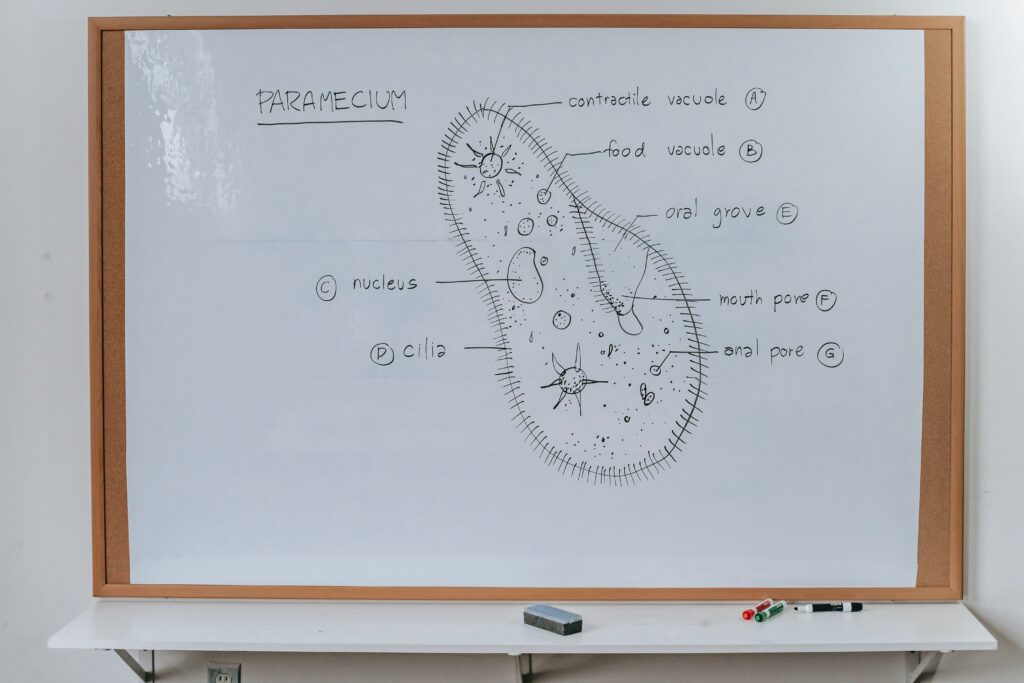An amoeba obtains its food through a process called phagocytosis, which involves engulfing and digesting food particles. Here’s a step-by-step explanation of how an amoeba obtains its food:
Extension of pseudopods:
An amoeba extends finger-like projections called pseudopods, which help it move and capture food. These pseudopods are temporary and can be extended in any direction.
Recognition and trapping:
When an amoeba comes across a potential food source, such as bacteria or organic debris, it recognizes it through chemical cues. The pseudopods surround the food item, trapping it in a temporary food vacuole.
Formation of food vacuole:
The pseudopods fuse together, enclosing the food particle within a membrane-bound structure called a food vacuole. The food vacuole separates the ingested material from the rest of the cell’s cytoplasm.
Digestion:
Once the food is inside the food vacuole, the amoeba secretes enzymes into the vacuole to break down the food into smaller molecules. These enzymes, typically digestive enzymes, help in the process of extracellular digestion.
Absorption:
The smaller molecules resulting from the digestion process, such as simple sugars, amino acids, and fatty acids, are absorbed across the vacuolar membrane into the cytoplasm of the amoeba. This allows the nutrients to be utilized for energy production and other metabolic processes.
Expulsion of waste:
After digestion and absorption, any undigested or waste material is eliminated from the amoeba’s body through exocytosis. The food vacuole fuses with the cell membrane, expelling the indigestible material outside the cell.

It’s important to note that amoebas are unicellular organisms and lack specialized digestive organs found in complex multicellular organisms. They rely on the process of phagocytosis to capture and digest their food, and their flexible cell membrane allows them to change shape and engulf larger particles.
FAQS Section
An amoeba obtains its food through phagocytosis, where it extends pseudopods to capture and engulf food particles.
Pseudopods are temporary extensions of an amoeba’s cell membrane that resemble finger-like projections. They help the amoeba move and capture food by surrounding and trapping the food particles.
Amoebas recognize their food source through chemical cues. They are sensitive to changes in the concentration of substances, allowing them to detect the presence of potential food particles.
After capturing food, the amoeba forms a temporary food vacuole by fusing the pseudopods. The food vacuole encloses the ingested material and separates it from the rest of the cell’s cytoplasm.
Within the food vacuole, the amoeba secretes enzymes to break down the food particles into smaller molecules. These enzymes facilitate the process of extracellular digestion.
The smaller molecules resulting from the digestion process, such as simple sugars, amino acids, and fatty acids, are absorbed across the vacuolar membrane into the amoeba’s cytoplasm.
Any undigested or waste material is expelled from the amoeba’s body through exocytosis. The food vacuole fuses with the cell membrane, releasing the indigestible material outside the cell.
Phagocytosis is essential for an amoeba’s survival as it enables the organism to obtain nutrients for energy production and metabolic processes. It ensures the amoeba’s ability to grow, reproduce, and maintain its biological functions.
Conclusion
In conclusion, the amoeba obtains its food through the process of phagocytosis, which involves capturing and engulfing food particles using its pseudopods. This remarkable unicellular organism relies on its ability to extend these temporary projections and form a food vacuole to enclose the ingested material.
Through the secretion of digestive enzymes, the amoeba breaks down the food particles into smaller molecules, which are then absorbed into its cytoplasm for energy production and other metabolic processes.
Any waste material is eliminated through exocytosis. The process of phagocytosis is vital for the amoeba’s survival, allowing it to acquire the necessary nutrients for growth, reproduction, and maintaining its biological functions. The amoeba’s adaptive mechanism of obtaining food highlights the remarkable versatility and resourcefulness of single-celled organisms in their quest for survival and sustenance.





